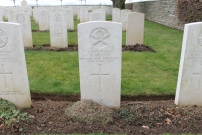| First Name: | Henry | Last Name: | DILLEY | |
|---|---|---|---|---|
| Date of Death: | 10/04/1917 | Lived/Born In: | Kingsland | |
| Rank: | Private | Unit: | Machine Gun Corps 167th Company | |
| Memorial Site: | ||||
Current Information:Enlisted-Dalston Warlincourt Halte British Cemetery, Saulty, France
At the outbreak of war in 1914 there were two machine guns to each battalion which was far from adequate and substantially fewer than the German Army. The need for more of these weapons and the specialised training they required led to the establishment of Machine Gun Corps in the autumn of 1915 with each infantry brigade being furnished with their own machine gun company, usually taking the same number as the brigade. These companies were equipped with the new Vickers machine gun whilst the individual infantry battalions were supplied with the lighter, hand-held Lewis guns. Machine Gun Battalions were formed in the Divisions in the early months of 1918, by bringing together the four MGC Companies into a single command structure. The Battalions took the number of their Division. The Battle of Arras was a series of offensives by the British Army between 9th April 1917 and 16th May 1917. It had been planned in conjunction with the French who would attack in Artois and between them the Allies would force the Germans out of the large salient they had held since the line of trenches was first established. But the Germans had spoiled this plan by falling back to the new and very strong Hindenburg Line in January 1917 and the salient no longer existed. For the want of an alternative plan the attack went ahead anyway. It all started well for the British who made substantial gains on the first two days but then the offensive ground to a halt and by the end their losses amounted to over 150,000.
The First Battle of the Scarpe (9-14 April) 56th (London) Divisionattacked at 7.45 on the morning of 9th April, 1917 with their objective being the Wancourt-Feuchy trench system, the Brown line. 167 Brigade, including the 167th Company of the Machine Gun Corps attacked on the right of the divisional front with 3rd London on the right and 8th Middlesex on the left, their first objective being the southern half of the heavily fortified village of Neuville-Vitasse after which 1st London and 7th Middlesex would pass through to continue the attack. Two platoons of 3rd London had the additional task of capturing Neuville Mill which they succeeded in doing with the help of a tank. 3rd London reached their objective without meeting too much opposition but 8th Middlesex had a harder fight and were held up around the church where the wire was uncut. Eventually after a hard fight, this was overcome but 8th Middlesex had lost the barrage and it was only with difficulty that they reached their final objective at 4pm. Despite this 1st London was able to pass through to the south of them at 12.10pm and attack the Hindenburg Line. They cleared Neuville-Vitasse Trench but suffered heavy casualties in the process and when 7th Middlesex moved up for their advance, they found 1st London held up in front of the Hindenburg Line. They immediately went to their aid and between them 7th Middlesex and 1st London captured the first part of the Hindenburg Line.However, in the confusion of battle, the troops had bunched together and were not in touch with 168 Brigade on their left. Later 7th Middlesex twice attacked the support trench but were stopped both times by machine-gun fire from the right. By the end of the day, 56th Division had advanced some 2000 yards, but not without cost having sustained over 800 casualties including Henry Dilley of the 167th Company, Machine Gun Corps who died from wounds on the following day. |
||||
| « Back to Search Results | ||||
| If you think any of the information shown here is incorrect, Click Here to submit your amends and comments | ||||




